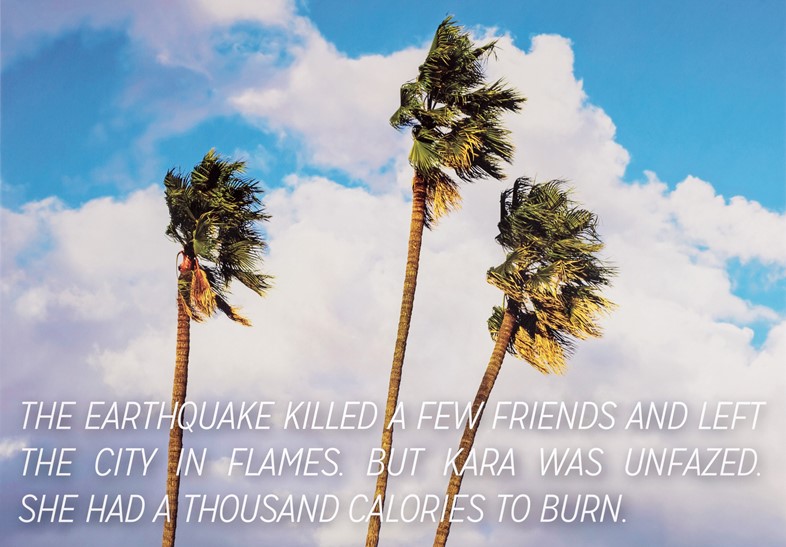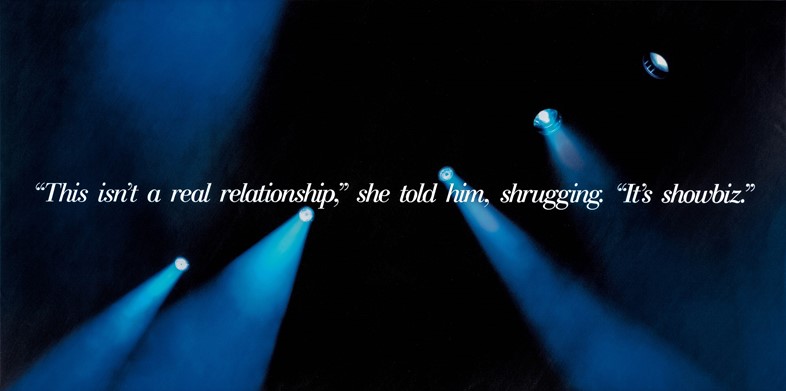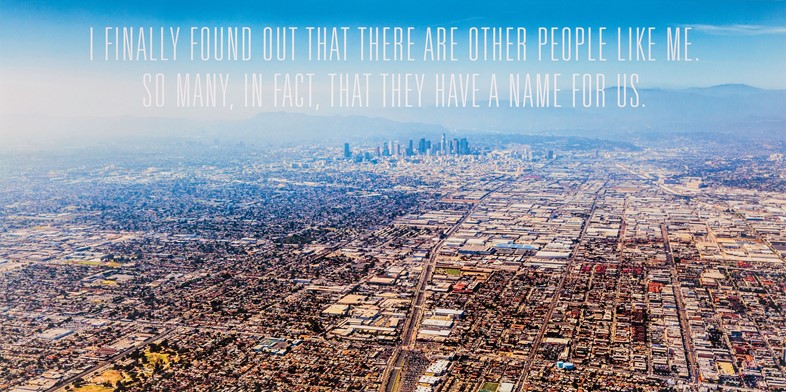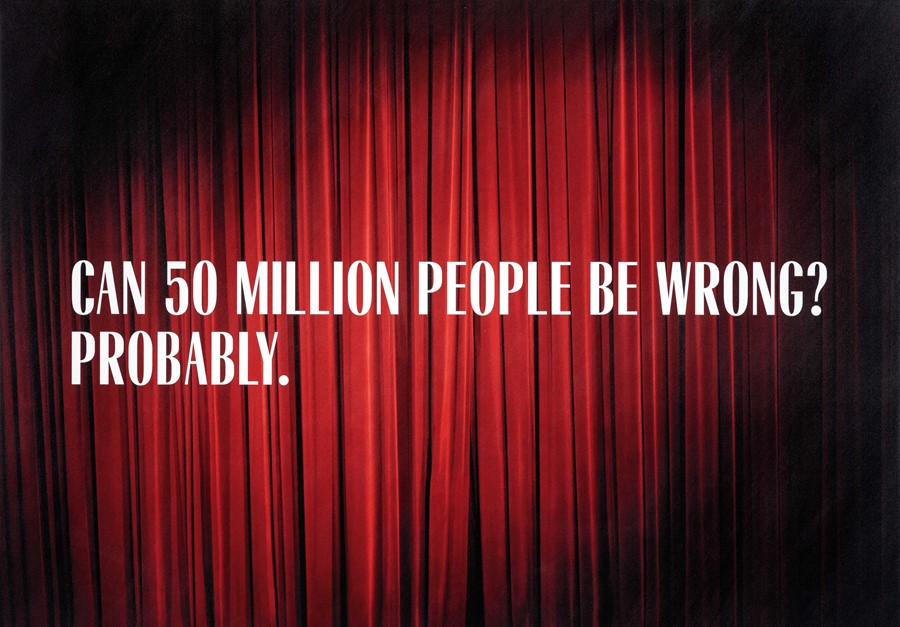We catch up with the feted author and artist to discuss their hyper-filmic artworks currently on display at London’s Gagosian gallery
Two vast paintings the size of cinema screens adorn the front-facing windows of London’s Gagosian gallery on Davies Street. “Can 50 million people be wrong? Probably,” one asks, and answers itself, in bold white capitals set against a crimson, spotlit stage curtain. Its deep blue pendant shows a row of small stage lights, which cast long beams in different directions. Across its centre is written: “‘This isn’t a real relationship,’ she told him shrugging. ‘It’s show biz.’” In a world where the President of the United States boasts a Twitter addiction and fake news abounds, these hyper-filmic pieces – a collaboration between American author Bret Easton Ellis and visual artist Alex Israel – pack a particularly strong punch.
Interestingly, however, they were made prior to Trump’s election. “‘Can 50 million people be wrong?’ was actually about American Idol, Alex’s favourite show, and the voting process,” laughs Easton Ellis, sitting next to Israel in one of the Gagosian’s small side rooms. “And now the meaning is completely different!” This, they explain, was the main motivation behind their new show, a follow up to the first exhibition of their gargantuan works held during last year’s Oscars in the Gagosian Beverly Hills. “The Beverly Hills show was themed around doubles, and the fact that in Los Angeles many people lead double lives,” Israel expands. “We picked 15 works we felt were right for that show, out of hundreds of mock ups based upon thousands of texts that Bret had written, and then, afterwards, we realised that some of the pieces we hadn’t shown could now be read in new, very relevant ways. Suddenly it felt much more urgent for them to be exhibited, and we’ve made some new works too.”

The duo met in 2010 when Israel, who cites Easton Ellis’ work as a key influence on his distinct brand of contemporary pop art, interviewed the American Psycho author for Purple magazine. They instantly forged a connection, Israel inviting Easton Ellis to join forces on the art project a few years later. The ongoing collaboration is a musing on Los Angeles, where both creatives were born and raised, and is intended as “a slideshow of the city’s subconscious”. The pair’s working process is now a slick “back and forth” routine: they meet in a bar in an LA mall to swap ideas, Easton Ellis writes his brooding, flash fiction-esque texts based on their discussions and Israel scours iStock for scenic imagery that best illustrates their sentiments, and selects a complementary font. The final pieces are printed and painted at Warner Bros., by the team responsible for conjuring up the studio’s movie backdrops, cementing their relationship to LA and the Hollywood film industry.
For the London show only two works will be on display at any one time, with three sets of pairs being shown on rotation in the gallery windows “in order to engage with the street, sort of like advertisements,” Israel says. Here, in celebration of the show’s opening, we catch up with the charismatic collaborators to talk LA’s noir past and optimistic future, and art and craft in the digital age.

On their working relationship...
AI: “We were both born in LA, but we come from different generations and we have different outlooks; Bret is always joking that he’s more pessimistic and I’m more optimistic, and that’s true. Working together, he forces me a little bit out of my comfort zone and I bring him a little bit out of his and we meet somewhere in the middle. And that provides a place for tension, in a way, like two parts of you colliding.”
BEE: “But in spite of our differences of sensibility at times, we do completely agree on the aesthetic of this show. We’re one hundred per cent on the same page about the grandness of scale and drama, whereas someone else might not get it. Alex did not have to sell me on anything to do this.”
On capturing the spirit of LA...
BEE: “When I was writing the texts, I was thinking about LA in terms of dramatic narratives; I wanted there to be tension in the text. I was thinking about noir, about Raymond Chandler, about Joan Didion. I was thinking about iconic LA bands like The Eagles, and about The Doors. Alex and I also agreed that LA is underscored by a false narrative: people go to LA to reinvent themselves but, really, the city invents you. It’s very brutal.”
AI: “Yes, but it also has this magical quality for all sorts of different reasons, some of which have been around for a long time. Chandler and Didion’s writing about it still feels relevant; those anxieties and emotions are still part of the landscape of the city. As much as it grows and evolves and becomes more globalised, it’s still a beach town, a place with canyons that people can hide away in, a place where the sun shines almost every day. Those things really do attack you – it’s like being a trance-like state when you’re in Los Angeles.”
On the city’s contemporary renaissance…
BEE: “LA’s always been considered the city of the future in the United States and it is now more than ever because it’s become a place where young people can live. Kids can’t go to San Francisco because of the cost; Manhattan’s a gated community. LA’s pricey, but people are finding ways to make it work. Huge pockets of it are being gentrified: there are lots of twenty-somethings living in Atwater Village, which used to be this Vietnamese enclave way outside of the main centre of the city. So I am much more optimistic about LA now than I was when I wrote Less Than Zero. There was a lot of pain and alienation then; it seemed like a very dark city. Maybe it was just me at the time, but I don’t view LA like that anymore.”
On art and craft in the social media age…
BEE: “I believe that novels and films change people’s lives. I think that putting yourself in other people’s shoes makes you empathetic and empathy is something that is truly lacking in the social media world. It’s all me, me, me; my bubble; my feed. It has encouraged an exhibitionistic display culture, and people are so lost in their own navel gazing that you don’t see influences happening in the way that they did. Alex is more optimistic than I am but I don’t know where this ends up. The absence of an analogue, tactile truth, of a world where everything is actually real. Certainly for the arts, it’s a big question mark. A lot of the permanence of connoisseurship is being lost in a tidal wave of disposability. Culture has become so democratised that the notion of craft is gone.”
AI: “Craft just becomes something else. You could have said 50 years ago, ‘We’re no longer in the era of opera or ballet’, just like we’re talking about movies and novels today. But there are still choices we make in terms of who we follow on Instagram or which pictures we like, and those choices are dictated by the craft of the person we’re following. The Kardashians have the best, most honed skills at this craft. They’re the old masters of social media. Craft is changing; connoisseurship is looking at a different set of standards. In some ways I feel like culture in the social media age is more relatable.”

On contemporary pop culture...
BEE: “I love The Hills, I like Girls, I love the Robyn record Dancing On My Own… I’ve been around long enough to completely immerse myself in digital media but there still seems to be a degradation of the arts through the democratisation of the arts. Maybe that’s just me, I always was a kid with issues: ‘No, that’s not good enough!’ I preferred Robert Altman movies to Star Wars – that was me at 12. I saw Three Women four times in May ‘77. I only saw Star Wars once, the same week.”
AI: “The thing that inspires me about pop culture is that you watch or listen to something and you think, ‘Oh my God, this is the best movie I’ve ever seen or this is the best song I’ve ever heard; I’ll never enjoy another song this much.’ And then, a year later, another song comes out and you say the same thing again. And you get so excited again because here it is: it’s been a year’s wait but it’s just as good.”
On the best LA-based artwork...
AI: “A Bigger Splash by David Hockney – I can’t wait to see the new Tate show while we’re here.”
BEE: “My go-tos are always films. I’ve been really interested in noir lately and watching a lot of the old LA noir of the 40s and 50s. It reveals a city that I can’t believe existed. It’s so bare boned and hard boiled, pared down, minimalist and dark... The post-war attitude that permeates everything is so powerful. Interestingly, I do think some of the modern noir has improved upon the older films. My favourite LA film is probably Robert Altman’s A Long Goodbye. It really is the best of the Raymond Chandler adaptations.”
On their favourite LA spots…
AI: “I love the Big Chill. It’s a frozen yogurt spot that my family opened in the 80s. They no longer own it but I still go there all the time: it’s on the corner of West Boulevard and Olympic. Great frozen yogurt!”
BEE: “I love the ArcLight cinemas on the corner of Sunset Boulevard and Vine. It’s the nicest cinema complex in Los Angeles. The main theatre is called the Cinerama Dome and was built in the early 60s. They’re just beautiful theatres; there’s 15 of them, all state of the art. I find no more relaxing place to go to on a Tuesday at 2 o’clock in the afternoon when there’s absolutely no one there.”
Alex Israel and Bret Easton Ellis is open at Gagosian, Davies Street until March 18, 2017.
